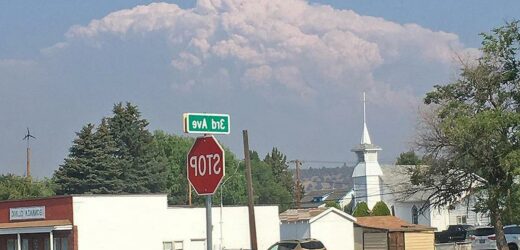Bly, Oregon — Erratic winds and parched Oregon forests added to the dangers for firefighters on Monday as they battled the largest wildfire in the U.S., one of dozens burning across several Western states.
The destructive Bootleg Fire was considered one of the largest in modern Oregon history and was burning more than 476 square miles, an area about the size of Los Angeles and three times the size of Detroit. The blaze just north of the California border was about 25% contained.
National Weather Service satellite images showed a huge plume of smoke from Bootleg, in southern Oregon, to the Canadian border, hundreds of miles northeast, the Agence France-Presse news service noted.
There were about 80 active large fires and complexes of multiple blazes in the U.S., the National Interagency Fire Center tweeted late Sunday. The U.S. Forest Service said at least 16 major fires were burning in the Pacific Northwest alone.
#NationalFireNews: 80 wildfires have burned 1,157,976 acres in 13 states. More than 19,700 wildland firefighters & support personnel & 35 Type 1 & Type 2 incident management teams are assigned to wildfires. To date, 34,941 wildfires have burned 2,509,231 acres. #FireYear2021 pic.twitter.com/JpY7STe4TN
Meteorologists predicted critically dangerous fire weather through at least Monday, with lightning possible in both California and southern Oregon.
“With the very dry fuels, any thunderstorm has the potential to ignite new fire starts,” the National Weather Service in Sacramento, California, said on Twitter.
CBS News weather producer David Parkinson said, “In California, the big concern Monday is a second day of ‘dry lightning.’ Essentially, monsoon moisture moves up into California but thew state is so hot and dry, the rain evaporates before it hits the ground, so all you get is lightning and gusty winds that switch directions. That’s a problem for new fire starts and sudden changes to existing ones.”
Thousands of people were already facing evacuation orders, including some 2,000 who live in the largely rural areas of lakes and wildlife refuges near the fire, which has burned at least 67 homes and 100 outbuildings while threatening many more.
Extremely dry conditions and heat waves tied to climate change have swept the region, making wildfires harder to fight. Climate change has made the West much warmer and drier in the past 30 years and will continue to make weather more extreme and wildfires more frequent and destructive.
Firefighters said in July they were facing conditions more typical of late summer or fall.
Pyrocumulus clouds – literally translated as “fire clouds” – complicated containment efforts for the Dixie Fire in northern California on Sunday, as well as flames that spread to remote areas with steep terrain that are harder for crews to reach, officials said. New evacuation orders were issued in rural communities near the Feather River Canyon.
The Dixie Fire remained 15% contained and covered 29 square miles. The fire is northeast of the town of Paradise, California, and survivors of that horrific fire that killed 85 people watched warily as the blaze burned.
A growing wildfire south of Lake Tahoe jumped a highway, prompting more evacuation orders, the closure of the Pacific Crest Trail and the cancellation of an extreme bike ride through the Sierra Nevada.
The Tamarack Fire, which was sparked by lightning on July 4, had charred about 28.5 square miles of dry brush and timber as of Sunday night. The blaze was threatening Markleeville, a small town close to the California-Nevada state line. It has destroyed at least two structures, authorities said.
A notice posted Saturday on the 103-mile Death Ride’s website said several communities in the area had been evacuated and ordered all bike riders to clear out. The fire left thousands of bikers and spectators stranded in the small town and racing to leave.
Source: Read Full Article



